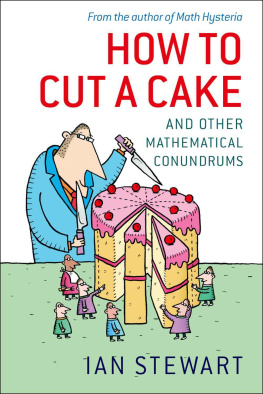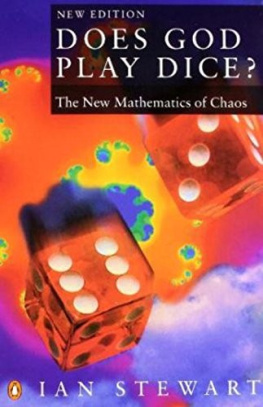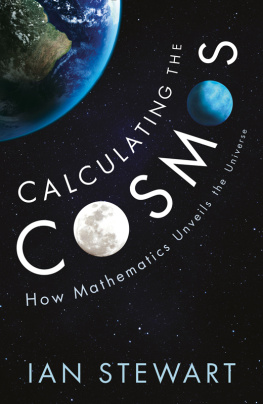Mathematics did not spring into being fully formed. It grew from the cumulative efforts of many people, from many cultures, who spoke many languages. Mathematical ideas that are still in use today go back more than 4000 years.
Many human discoveries are ephemeral the design of chariot wheels was very important in New Kingdom Egypt, but its not exactly cutting-edge technology today. Mathematics, in contrast, is often permanent. Once a mathematical discovery has been made, it becomes available for anyone to use, and thereby acquires a life of its own. Good mathematical ideas seldom go out of fashion, though their implementation can change dramatically. Methods for solving equations, discovered by the ancient Babylonians, are still in use today. We dont use their notation, but the historical link is undeniable. In fact, most of the mathematics taught in schools is at least 200 years old. The advent of modern mathematics curricula in the 1960s brought the subject into the 19th century. But contrary to appearances, mathematics has not stood still. Today, more new mathematics is created every week than the Babylonians managed in two thousand years.
The rise of human civilization and the rise of mathematics have gone hand in hand. Without Greek, Arab and Hindu discoveries in trigonometry, navigation across the open ocean would have been an even more hazardous task than it was when the great mariners opened up all six continents. Trade routes from China to Europe, or from Indonesia to the Americas, were held together by an invisible mathematical thread.
Todays society could not function without mathematics. Virtually everything that we now take for granted, from television to mobile phones, from wide-bodied passenger jets to satellite navigation systems in cars, from train schedules to medical scanners, relies on mathematical ideas and methods. Sometimes the mathematics is thousands of years old; sometimes it was discovered last week. Most of us never realize that it is present, working away behind the scenes to empower these miracles of modern technology.
This is unfortunate: it makes us think that technology works by magic, and leads us to expect new miracles on a daily basis. On the other hand, it is also entirely natural: we want to use these miracles as easily and with as little thought as possible. The user should not be burdened by unnecessary information about the underlying trickery that makes the miracles possible. If every airline passenger were made to pass an examination in trigonometry before boarding the aircraft, few of us would ever leave the ground. And while that might reduce our carbon footprint, it would also make our world very small and parochial.
To write a truly comprehensive history of mathematics is virtually impossible. The subject is now so broad, so complicated and so technical, that even an expert would find such a book unreadable leaving aside the impossibility of anyone writing it. Morris Kline came close with his epic Mathematical Thought from Ancient to Modern Times. It is more than 1200 pages long, in small print, and it misses out almost everything that has happened in the last 100 years.
This book is much shorter, which means that I have had to be selective, especially when it comes to mathematics of the 20th and 21st centuries. I am acutely conscious of all the important topics that I have had to omit. There is no algebraic geometry, no cohomology theory, no finite element analysis, no wavelets. This list of whats missing is far longer than the list of what is included. My choices have been guided by what background knowledge readers are likely to possess, and what new ideas can be explained succinctly.
The story is roughly chronological within each chapter, but the chapters are organized by topic. This is necessary to have any kind of coherent narrative; if I put everything into chronological order the discussion would flit randomly from one topic to another, without any sense of direction. This might be closer to the actual history, but it would make the book unreadable. So each new chapter begins by stepping back into the past, and then touching upon some of the historical milestones that were passed as the subject developed. Early chapters stop a long way in the past; later chapters sometimes make it all the way to the present.
I have tried to give a flavour of modern mathematics, by which I mean anything done in the last 100 years or so, by selecting topics that readers may have heard of, and relating them to the overall historical trends. The omission of a topic does not imply that it lacks importance, but I think it makes more sense to spend a few pages talking about Andrew Wiless proof of Fermats Last Theorem which most readers will have heard of than, say, non-commutative geometry, where the background alone would occupy several chapters.
In short, this is a history, not the history. And it is history in the sense that it tells a story about the past. It is not aimed at professional historians, it does not make the fine distinctions that they find necessary, and it often describes the ideas of the past through the eyes of the present. The latter is a cardinal sin for a historian, because it makes it look as though the ancients were somehow striving towards our current way of thinking. But I think it is both defensible and essential if the main objective is to start from what we now know and ask where those ideas came from. The Greeks did not study the ellipse in order to make possible Keplers theory of planetary orbits, and Kepler did not formulate his three laws of planetary motion in order for Newton to turn them into his law of gravity. However, the story of Newtons law rests heavily on Greek work on the ellipse and Keplers analysis of observational data.
A sub-theme of the book is the practical uses of mathematics. Here I have provided a very eclectic sample of applications, both past and present. Again, the omission of any topic does not indicate that it lacks importance.
Mathematics has a long, glorious, but somewhat neglected history, and the subjects influence on the development of human culture has been immense. If this book conveys a tiny part of that story, it will have achieved what I set out to do.
C OVENTRY, M AY 2007
Tokens, Tallies and Tablets
The birth of numbers

Mathematics began with numbers, still fundamental, even though the subject is no longer limited to numerical calculations. By building more sophisticated concepts on the basis of numbers, mathematics has developed into a broad and varied area of human thought, going far beyond anything that we encounter in a typical school syllabus. Todays mathematics is more about structure, pattern and form than it is about numbers as such. Its methods are very general, and often abstract. Its applications encompass science, industry, commerce even the arts. Mathematics is universal and ubiquitous.
It started with numbers
Over many thousands of years, mathematicians from many different cultures have created a vast superstructure on the foundations of number: geometry, calculus, dynamics, probability, topology, chaos, complexity and so on. The journal Mathematical Reviews, which keeps track of every new mathematical publication, classifies the subject into nearly a hundred major areas, subdivided into several thousand specialities. There are more than 50,000 research mathematicians in the world, and they publish more than a million pages of new mathematics every year. Genuinely new mathematics, that is, not just small variations on existing results.


















